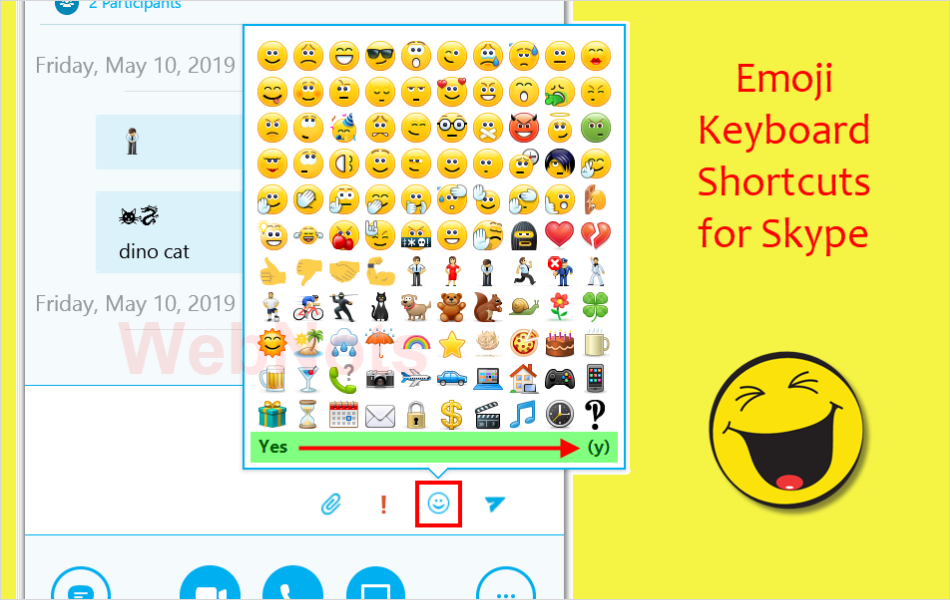Somewhat annoyingly, Google hasn’t documented any of their Hangouts keyboard shortcuts to tell you that when you urgently need to insert 💩 (pile of poo U+1F4A9) you can just type ~@~. It’d be nice if there were a public list somewhere, or mouse hovering gave you some clues about using a shortcut. But there isn’t anything helpful.
UNTIL NOW. 😲
If you go searching through the Google Hangouts source code, you’ll discover that they’re actually all backed by regular Unicode characters. Their smiling emoji is the Unicode character 😃 (smiling face with open mouth U+1F603) and they replace it with one of their custom images.
Methods of Using Emoji You can use the alt key shortcuts in the first column of the above table on Microsoft Word, Excel, PowerPoint and any other Office documents. Hold one of the alt keys on your keyboard and press the numbers on your number pad. Remember these shortcuts will only work on the keyboard with number pad. The emoji keyboard also keeps a Frequently Used section on the left. Most people have limited palette of words that they use in everyday speech. And we have an even smaller pool of oft-used emojis. Every emoji by name, code and shortcode. Copy and paste emoji codes to insert emojis on any supported platform including Mac, Windows, iOS and Android. Mac Emojis Shortcut. To bring up Mac emojis, you can press Control + Command (⌘) + Space. Sticky notes to help understand twitter. It brings up a window with the same emojis you can find on iOS. But there’s much more than that.
The upshot is when you copy text from elsewhere on the web and paste it into your Hangouts message, you won’t lose important characters like 💩. (If you’re careful with your mouse you can also copy a Hangouts emoji image from the grid, paste it somewhere, and it’ll work.)
Shortcut Key For Emoji On Mac
This is the web, though, so view source a little harder and you can find a set of mappings in a JavaScript file, containing all the keyboard shortcuts which will get replaced:
128515 is decimal-speak for the hexadecimal value 0x1F603, corresponding to 😃 (smiling face with open mouth U+1F603). When you type :) in a message, they see it has a corresponding emoji and replace it accordingly.
A full list is then pretty easy to automatically build.
So I present what I think is the first, and only, publicly available list of all Google Hangouts emoji keyboard shortcuts.
-<@% | 🐝 | honeybee (U+1F41D) |
:(|) | 🐵 | monkey face (U+1F435) |
:(:) | 🐷 | pig face (U+1F437) |
(]:{ | 👳 | man with turban (U+1F473) |
<3</3 | 💔 | broken heart (U+1F494) |
<3 | 💜 | purple heart (U+1F49C) |
~@~ | 💩 | pile of poo (U+1F4A9) |
:D:-D | 😀 | grinning face (U+1F600) |
^_^ | 😁 | grinning face with smiling eyes (U+1F601) |
:):-)=) | 😃 | smiling face with open mouth (U+1F603) |
=D | 😄 | smiling face with open mouth and smiling eyes (U+1F604) |
^_^;; | 😅 | smiling face with open mouth and cold sweat (U+1F605) |
O:)O:-)O=) | 😇 | smiling face with halo (U+1F607) |
}:)}:-)}=) | 😈 | smiling face with horns (U+1F608) |
;);-) | 😉 | winking face (U+1F609) |
B)B-) | 😎 | smiling face with sunglasses (U+1F60E) |
:-|:|=| | 😐 | neutral face (U+1F610) |
-_- | 😑 | expressionless face (U+1F611) |
o_o; | 😓 | face with cold sweat (U+1F613) |
u_u | 😔 | pensive face (U+1F614) |
::/:-:-/==/ | 😕 | confused face (U+1F615) |
:S:-S:s:-s | 😖 | confounded face (U+1F616) |
:*:-* | 😗 | kissing face (U+1F617) |
;*;-* | 😘 | face throwing a kiss (U+1F618) |
:P:-P=P:p:-p=p | 😛 | face with stuck-out tongue (U+1F61B) |
;P;-P;p;-p | 😜 | face with stuck-out tongue and winking eye (U+1F61C) |
:(:-(=( | 😞 | disappointed face (U+1F61E) |
>.<>:(>:-(>=( | 😡 | pouting face (U+1F621) |
T_T:'(;_;='( | 😢 | crying face (U+1F622) |
>_< | 😣 | persevering face (U+1F623) |
D: | 😦 | frowning face with open mouth (U+1F626) |
o.o:o:-o=o | 😮 | face with open mouth (U+1F62E) |
O.O:O:-O=O | 😲 | astonished face (U+1F632) |
x_xX-OX-oX(X-( | 😵 | dizzy face (U+1F635) |
:X):3(=^.^=)(=^.^=)=^_^= | 😸 | grinning cat face with smiling eyes (U+1F638) |
- Previous post
- Favicons over time
- Next post
- A summary of HTTP redirects
Today, one could argue that emoji dominate all forms of modern electronic communication, from instant messaging to advertising. First appearing in Japanese phones in the late 1990s, emoji have become ubiquitous only in early 2010s, when major smartphone manufacturers included them in their respective mobile operating systems.
Emoji enrich our conversations and elevate our words by infusing them with meaning that is hard to convey otherwise through a simple use of words. Ok, maybe not that hard for Faulkner, but for most of us on the go, typing a winking face is much more efficient than even trying to explain the meaning behind it.
In other words, by now all of us have emoji keyboards on our iPhones. They are near effortless: just switch the language and type. But it’s a completely different story on macOS. Does anyone really know how to add emoji on Mac effectively?
If you survey how most people type emoji on their Macs, you’d find lots of time-sucking hacks, such as finding the right emoji online and copy-pasting it into the message or downloading apps full of adware that promise a full emoji collection. Luckily, there are a few better ways to do that.
Let Setapp help you with emojis
Get an ultimate collection of Mac apps for any job. Setapp gives you apps for saving emojis, creating shortcuts, sharing content, and whatnot.
How To Type Emoji On Mac
Good news is that all emoji you’ll ever need are already available on your Mac. No need to go looking for them online to copy over.
If you’re not sure how to get emoji keyboard on Mac, do this:
- Open System Preferences ➙ Keyboard
- Check the box next to “Show keyboard and emoji viewers in menu bar”
- Click on the keyboard flag in the menu bar to open emoji keyboard on Mac and select Show Emoji & Symbols

As you can see the Character Viewer does not only contain all the supported emoji, it also features hundreds of rare and normally hidden characters from mathematics, other languages, punctuation, and more.
To see all the available characters, click on the cog in the top-left corner and choose Customize List. There you can include even more categories of braille patterns, various scripts, and code tables. You can also uncheck specific categories you don’t need to simplify the emoji keyboard on Mac.
When you want to insert emoji on Mac, you first need to open a text editor or a program in which you’d like the emoji pasted. In case you’re writing a blog post, there’s nothing better here than Ulysses.
Ulysses is a full-featured writing app that lets you focus on words with no distractions. With support for Markdown, sync with iCloud, and multiple export options directly to WordPress or Medium, it covers all the essentials without being bloated as many contemporary word processors are.
If you need to know how to type emoji on Mac while working on Ulysses, simply click on the keyboard layout icon from the menu bar, select Show Emoji & Symbols once again, set the typing cursor where you want your emoji to be placed and double-click on the emoji from the Character Viewer menu.
To make emoji typing workflow more seamless, click on the top-right icon in the Character Viewer menu, and it will switch to the inline mode, which makes it much easier to insert emoji on Mac.
Learn the essential emoji shortcut on Mac
Even though placing the Character Viewer window in the menu bar gives it the prominence it has never had before, you don’t always want to stop typing, switch to your trackpad, and navigate all the way up there. It’s just too distracting. Luckily, there is an easy-to-remember emoji shortcut on Mac — Control + ⌘ + Space.
If you turned on the Character Viewer to display inline and use the shortcut mentioned above, you can then navigate all the emoji using standard Mac arrow keys and paste any emoji in by pressing Return.

It could be though that you don’t want to use Control + ⌘ + Space as a shortcut for the Character Viewer menu — no problem, you can change that as well.
To use a different shortcut for emoji keyboard on Mac:
- Open System Preferences ➙ Keyboard
- Navigate to the Shortcuts tab
- Click on App Shortcuts in the sidebar
- Press the plus icon to create a new shortcut (as the default Character Viewer shortcut is not listed anywhere)
- In the new pop-up menu, set Application to All Applications, Menu Title to Emoji & Symbols, and Keyboard Shortcut to the shortcut of your choice (e.g. Control + ⌘ + E)
- Click Add
Make sure to add a shortcut combination that is not yet taken by anything else; otherwise, the original action the shortcut belonged to will be left blank.
Truth be told, although setting a single shortcut with the built-in shortcut manager might be fine, remembering another handful of changes suddenly becomes much more difficult. So if you plan on changing any shortcuts in the future at all, you’d be better off by starting with a professional app like BetterTouchTool.
Power over your input devices
Shortcuts For Emojis On Mac
Install BetterTouchTool and you’ll have the power to customize any shortcut on Mac. Govern your emoji keyboard the way you want.
BetterTouchTool is the most complete manager for all your Mac input devices, be it a keyboard, trackpad, Touch Bar, or anything else. It lets you customize any shortcut for any action with a few clicks and even records key sequences, with which you don’t need to hold all keys at once to trigger an action.
To set a shortcut and open emoji keyboard on Mac with BetterTouchTool:
- Navigate to the Keyboard tab within the app
- Click “Add New Shortcut or Key Sequence” at the bottom
- Enter the new shortcut in the shortcut field
- Type in the shortcut to be replaced in the “Trigger Other Keyboard Shortcut” field
Now every time you use the new keyword, it would trigger the one you had before. You can similarly adjust other input devices, such as a trackpad or mouse, by using the respective tab at the top. What’s unique about BetterTouchTool is that all keywords will be saved in one place and could be easily viewed and modified.
Trigger an emoji keyboard on Mac easily
In the end, typing emoji on Mac is not more difficult than doing so on your phone. Especially when you’re doing it inline in a word processor like Ulysses by using your personal shortcuts that were set in BetterTouchTool.
Best of all, both Ulysses and BetterTouchTool are available for you to try free via Setapp, a platform of more than 150 distinguished Mac apps and utilities that help you accomplish everything you need to do intuitively, without spending any time tinkering with settings.
Meantime, prepare for all the awesome things you can do with Setapp.
 Read on
Read onSign Up

